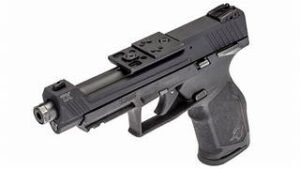Imagine this: you’re deep in the backcountry, miles from civilization. A sudden storm rolls in, cutting off cell service and leaving you stranded. But wait! You pull out your trusty handheld ham radio and crackle to life, connecting with fellow adventurers or rescuers.

Disclosure: Our website contains affiliate links, which means we may receive compensation if you purchase from recommended websites. We test and review these products independently and do not accept free products or incentives in exchange for positive reviews. Any opinions expressed here are our own.
Talk about a lifesaver! Ham radio communication offers a vital lifeline for outdoor enthusiasts, preppers, and anyone who wants reliable, off-grid communication. But with so many handheld ham radios on the market, choosing the right one can feel overwhelming.
Fear not, fellow explorers! We’ll dive into the top 5 handheld ham radios, dissecting their features, pros, and cons to help you find the perfect communication companion for your next adventure.
Why You Need a Dependable Handheld Ham Radio for Survival
Effective communication can be the line between safety and danger in unpredictable scenarios like natural disasters or wilderness adventures.
Enter handheld ham radios – a beacon of reliability when traditional modes break down.
Independent of regular infrastructure, they ensure you’re never out of touch. Let’s delve further into the best handheld ham radio.
Best 5 Handheld Ham Radios
Yaesu FT-65R ($$)
Description: The Yaesu FT-65R is a rugged, lightweight, and compact VHF/UHF handheld transceiver that offers up to 5W output power and lower power settings of 2.5W and 0.5W. It’s a popular choice for beginners and outdoor enthusiasts due to its durability and ease of use.
Features:
- VHF/UHF dual band operation (144 MHz and 440 MHz)
- 5W, 2.5W, and 0.5W power levels
- 128 channel memory
- Large, backlit LCD display
- Weather alert scanning
- Voice-activated transmission (VOX)
- Long battery life
- Durable and waterproof construction
- Retail: $142
Pros:
- Rugged and durable
- Easy to use
- Long battery life
- Affordable
- Water-resistant
Cons:
- Limited features compared to some higher-end models
- Scanning can be slow
- No memory bank system
Icom IC-V86 ($$)
Description: The Icom IC-V86 is a VHF handheld radio known for its exceptional build quality and durability. It’s a great choice for professionals and outdoor enthusiasts who need a reliable radio for critical communication.
Features:
- VHF single band operation (136 MHz – 174 MHz)
- 7W of power output with 200 channel memory
- Large, backlit LCD display
- Weather alert scanning
- Voice-activated transmission (VOX)
- Long battery life
- MIL-STD 810G durability rating
- IPX7 waterproof rating
- Retail: $156
Pros:
- Extremely rugged and durable
- Excellent audio quality
- Long battery life
- Waterproof
Cons:
- VHF only (no UHF)
- More expensive than some other options
- Larger and heavier than some VHF radios
Baofeng UV-5R ($)
Description: The Baofeng UV-5R is a very affordable dual-band handheld amateur radio that offers a wide range of features. It’s a popular choice for hobbyists and experimenters due to its low price point and ability to be programmed for use on various frequencies.
Features:
- VHF/UHF dual-band operation (136 MHz – 174 MHz and 400 MHz – 480 MHz)
- 4W of power output
- 128 channel memory
- Large, backlit LCD
- FM radio receiver
- Voice-activated transmission (VOX)
- Programmable for various frequencies
- Retail: $67
Pros:
- Very affordable
- Wide range of features
- Compact and lightweight
- Easy to program
Cons:
- Less durable than some other options
- Audio quality can be poor
- May not be legal to use on all frequencies without proper licensing
Ailunce HD1 DMR Handheld Radio ($$)
Description: The Ailunce HD1 DMR is a digital mobile radio (DMR) radio that offers superior audio quality and clarity compared to analog radios. It’s a great choice for users who want a reliable and clear communication option for group communication.
Features:
- VHF/UHF dual band operation (136 MHz – 174 MHz and 400 MHz – 480 MHz)
- Digital DMR mode and analog mode
- 3W of power output
- 1000 channel memory
- Large, backlit LCD display
- Voice activated transmission (VOX)
- Rugged and waterproof construction
- Retail: $160
Pros:
- Superior audio quality with DMR mode
- Rugged and waterproof
- Affordable for a DMR radio
- Long battery life (several days on a single charge), longest range
Cons:
- DMR mode requires other users to have DMR radios as well
- More complex to program than some analog radios
Kenwood TH-D74A ($$$$)
Description: The Kenwood TH-D74A is a high-end radio, tri-band handheld radio that offers VHF, UHF, and 1.25-meter band operation. It’s known for its excellent features and performance, making it a great choice for experienced ham amateur radio operators who need a versatile and powerful radio.
Features:
- VHF/UHF/1.25 meter tri-band operation (136 MHz – 174 MHz, 400 MHz – 480 MHz, and 1.24 GHz – 1.25 GHz)
- Analog FM, Digital Fusion, and D-STAR modes
- 5W of power output
- 1000 channel memory
- Large, backlit LCD display with touch screen
- GPS navigation
- APRS messaging
- Voice-activated transmission (VOX)
- Rugged and waterproof construction
- Retail: $800
Pros:
- Versatile tri-band operation
- Multiple digital modes for clear communication
- Powerful features for advanced users
- Rugged and waterproof
Cons:
- Most expensive on this list
- Larger and heavier than some other options
- More complex to program than some other radios
Buyer's Guide
With a trusty ham radio, you can connect with fellow adventurers, search and rescue teams, or anyone else within ham radio range.
Ham radio communication is vital for outdoor enthusiasts, preppers, and anyone who desires reliable, off-grid communication.

But with a vast array of handheld ham radios on the market, choosing the right one can feel like deciphering Morse code. Fear not, explorers!
This guide equips you with the knowledge to navigate the world of ham radios and find the perfect communication companion for your next adventure.
Step 1: Understanding Your Needs
Before diving into features, consider your primary needs for a ham radio. Here are some key questions to ask yourself:
Where will you be using it?
Backpacking trips, off-roading adventures, or simply around town? Ruggedness and portability might be priorities for outdoor use.
Who will you be communicating with?
Do you need a radio for group communication or simply basic emergency contact? Consider features like digital modes for clearer group chats.
What is your budget?
Handheld ham radios range from affordable options to feature-packed models. Determine a comfortable price range.
Do you have a ham radio license?
Legalizing ham radio requires a license from the Federal Communications Commission (FCC). Licenses come in different tiers and offer access to various frequencies.
Step 2: Decoding the Features
Now that you understand your needs, let’s explore some key features to consider:
- Frequency Bands: Most handheld ham radios operate on VHF and UHF bands, offering communication over short to medium distances. Tri-band radios add the 1.25-meter band for additional options.
- Analog vs. Digital Modes: Analog radios offer basic communication, while digital modes like DMR and D-STAR provide clearer audio and advanced features but require compatible radios on the other end.
- Power Output: Higher wattage (e.g., 5W) allows for greater range, which is important for reaching distant stations. However, lower-wattage radios (e.g., 2.5W) conserve battery life.
- Memory Channels: Store frequently used frequencies for quick access.
- Durability: Consider weatherproofing and rugged construction for outdoor use.
- Battery Life: A longer battery life ensures reliable communication during extended adventures.
- Additional Features: Look for features like GPS navigation, Bluetooth connectivity, or emergency SOS buttons for added functionality.
Step 3: Beyond the Basics: Resources and Next Steps
This guide equips you with the knowledge to choose the perfect ham radio for your needs. Here are some helpful resources for your next steps:
- The Federal Communications Commission (FCC): Get information on ham radio licensing and regulations.
- American Radio Relay League (ARRL): A leading organization for amateur radio enthusiasts, the ARRL offers educational resources and licensing information.
With the right knowledge and a trusty ham radio, you’ll be ready to communicate clearly and confidently, no matter where your adventures take you!
Conclusion
Maintaining a reliable line of communication is paramount in unpredictable situations. Handheld ham radios are vital for long-range communication, especially when conventional methods fail. Features like battery life, multiple charging options, and understanding different frequency bands enhance their utility.
In addition to radios, tools like whistles, mirrors, and flares and modern resources like survival podcasts are invaluable. Investing in these tools and continuously updating one’s knowledge empowers individuals to face challenging situations confidently, highlighting the importance of effective communication in adversity.








